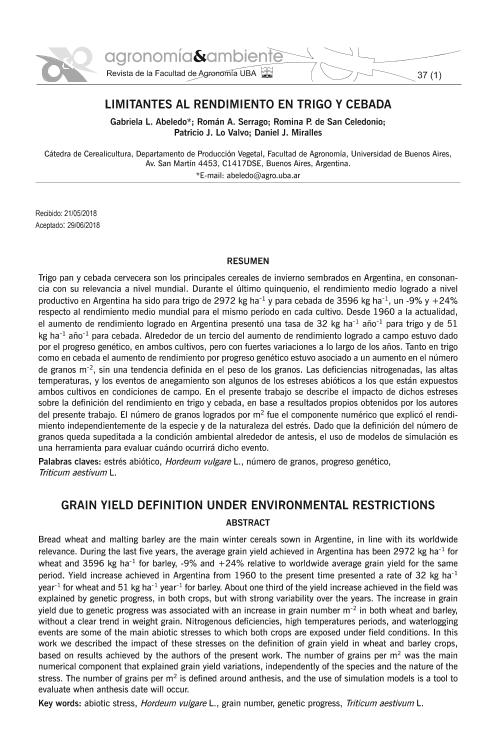Artículo
Trigo pan y cebada cervecera son los principales cereales de invierno sembrados en Argentina, en consonancia con su relevancia a nivel mundial. Durante el último quinquenio, el rendimiento medio logrado a nivel productivo en Argentina ha sido para trigo de 2972 kg ha-1 y para cebada de 3596 kg ha-1 , un -9% y +24% respecto al rendimiento medio mundial para el mismo período en cada cultivo. Desde 1960 a la actualidad, el aumento de rendimiento logrado en Argentina presentó una tasa de 32 kg ha-1 año-1 para trigo y de 51 kg ha-1 año-1 para cebada. Alrededor de un tercio del aumento de rendimiento logrado a campo estuvo dado por el progreso genético, en ambos cultivos, pero con fuertes variaciones a lo largo de los años. Tanto en trigo como en cebada el aumento de rendimiento por progreso genético estuvo asociado a un aumento en el número de granos m-2 , sin una tendencia definida en el peso de los granos. Las deficiencias nitrogenadas, las altas temperaturas, y los eventos de anegamiento son algunos de los estreses abióticos a los que están expuestos ambos cultivos en condiciones de campo. En el presente trabajo se describe el impacto de dichos estreses sobre la definición del rendimiento en trigo y cebada, en base a resultados propios obtenidos por los autores del presente trabajo. El número de granos logrados por m2 fue el componente numérico que explicó el rendimiento independientemente de la especie y de la naturaleza del estrés. Dado que la definición del número de granos queda supeditada a la condición ambiental alrededor de antesis, el uso de modelos de simulación es una herramienta para evaluar cuándo ocurrirá dicho evento. Bread wheat and malting barley are the main winter cereals sown in Argentine, in line with its worldwide relevance. During the last five years, the average grain yield achieved in Argentina has been 2972 kg ha-1 for wheat and 3596 kg ha-1 for barley, -9% and +24% relative to worldwide average grain yield for the same period. Yield increase achieved in Argentina from 1960 to the present time presented a rate of 32 kg ha-1 year-1 for wheat and 51 kg ha-1 year-1 for barley. About one third of the yield increase achieved in the field was explained by genetic progress, in both crops, but with strong variability over the years. The increase in grain yield due to genetic progress was associated with an increase in grain number m-2 in both wheat and barley, without a clear trend in weight grain. Nitrogenous deficiencies, high temperatures periods, and waterlogging events are some of the main abiotic stresses to which both crops are exposed under field conditions. In this work we described the impact of these stresses on the definition of grain yield in wheat and barley crops, based on results achieved by the authors of the present work. The number of grains per m2 was the main numerical component that explained grain yield variations, independently of the species and the nature of the stress. The number of grains per m2 is defined around anthesis, and the use of simulation models is a tool to evaluate when anthesis date will occur.
Limitantes al rendimiento en trigo y cebada
Título:
Grain yield definition under environmental restrictions
Abeledo, Leonor Gabriela ; Serrago, Roman Augusto
; Serrago, Roman Augusto ; de San Celedonio, Romina Paola
; de San Celedonio, Romina Paola ; Lo Valvo, Patricio Javier
; Lo Valvo, Patricio Javier ; Miralles, Daniel Julio
; Miralles, Daniel Julio
 ; Serrago, Roman Augusto
; Serrago, Roman Augusto ; de San Celedonio, Romina Paola
; de San Celedonio, Romina Paola ; Lo Valvo, Patricio Javier
; Lo Valvo, Patricio Javier ; Miralles, Daniel Julio
; Miralles, Daniel Julio
Fecha de publicación:
06/2018
Editorial:
Universidad de Buenos Aires. Facultad de Agronomía
Revista:
Agronomia&Ambiente
ISSN:
2314-2243
Idioma:
Español
Tipo de recurso:
Artículo publicado
Clasificación temática:
Resumen
Archivos asociados
Licencia
Identificadores
Colecciones
Articulos(IFEVA)
Articulos de INST.D/INV.FISIOLOGICAS Y ECO.VINCULADAS A L/AGRIC
Articulos de INST.D/INV.FISIOLOGICAS Y ECO.VINCULADAS A L/AGRIC
Articulos(OCA PQUE. CENTENARIO)
Articulos de OFICINA DE COORDINACION ADMINISTRATIVA PQUE. CENTENARIO
Articulos de OFICINA DE COORDINACION ADMINISTRATIVA PQUE. CENTENARIO
Citación
Abeledo, Leonor Gabriela; Serrago, Roman Augusto; de San Celedonio, Romina Paola; Lo Valvo, Patricio Javier; Miralles, Daniel Julio; Limitantes al rendimiento en trigo y cebada; Universidad de Buenos Aires. Facultad de Agronomía; Agronomia&Ambiente; 37; 1; 6-2018; 71-84
Compartir



